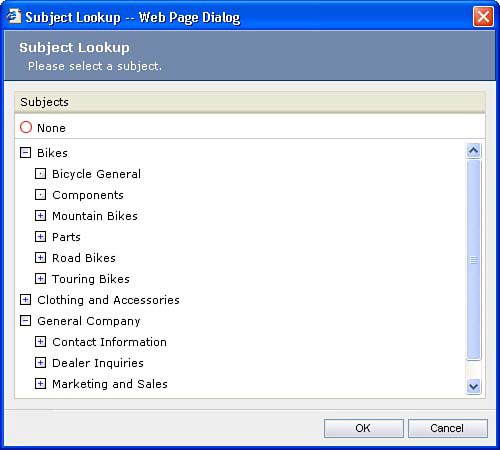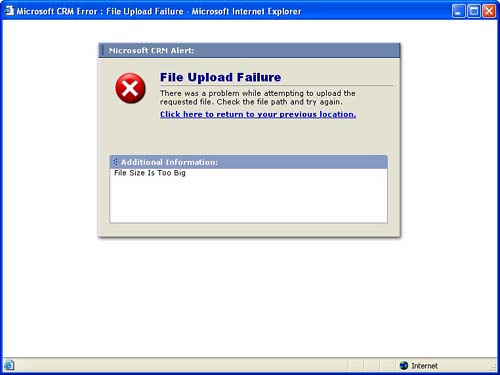Opportunities and Cases
Opportunities are records of any potential revenue generating events. Opportunities must be parented by a single Contact or Account record, but might have an unlimited number of associated contacts referred to as “Other Contacts.” In a Business to Consumer business model, an Opportunity will be parented by a Contact. In a Business to Business model, an opportunity will be parented by an Account. In their traditional usage, Opportunities are generally given a projected value (revenue potential), close date, and close probability (best guess as to whether you get the deal). However, in the case of a Financial Services sales professional whose job it is to influence brokers to influence their customers to buy particular securities, it might be impossible to assign projected revenue, close date, and close probability. Rather, you are tracking an ongoing process of relationship building that results in a steady stream of sales. A discussion of Business to Business (B2B) and Business to Consumer (B2C) models can be found in Chapter 7, “Sales Force Automation.” Figure 4.8 shows the Microsoft CRM Sales Opportunity screen.
Figure 4.8. The Microsoft CRM sales opportunity.
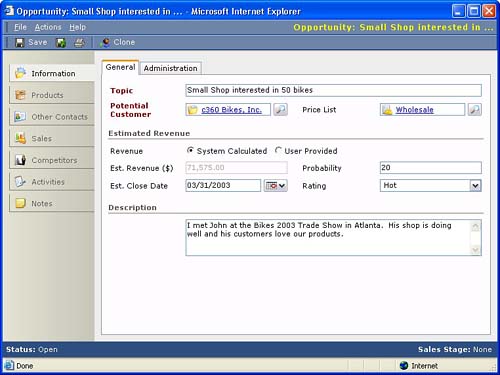
Cases are records used to track Customer Service interactions. Like Opportunities, either a Contact or an Account record must parent them. Key data points on a Case are its Title, Description, and the Subject to which it is related. The concept of Subjects will be discussed shortly. Note that Leads can parent neither Opportunities nor Cases. If the Lead is worth opening an Opportunity or Case for, convert it into a Contact and/or Account.
Activities and Notes
If you've previously used another CRM package, you might need to shake off your preconceptions to understand Activities and Notes in Microsoft CRM. Put simply, Activities can be associated with almost any record type and represent the various interactions you have related to that record. Activities are what most other CRM systems refer to as Notes. For example, if you call your Contact at an Account where you have an ongoing Opportunity, you would log that call in a Phone Call Activity parented by the Opportunity. The notes related to that phone call would go into the Phone Call Activity record. In contrast, if you are talking with a Contact at an Account and want to remember that the contact is an avid guitar player and Van Halen fan, you could create this as a Note attached to the Contact record. To summarize, Activities are interactions that can be read sequentially to recount a history. Notes can provide information that you want to set apart so as to be accessible without forcing the user to read through a long chain of interactions.
Another difference between Activities and Notes is that Activities can be linked to multiple CRM objects and Notes can only have a single parent CRM object, as shown in Figure 4.9. When you create a Note, you can't specify the Note's parent. The parent is the record from which you created the Note. However, when you create an Activity, there are several fields through which the Activity becomes linked. For example, if you send an email Activity to two Contacts and use the Activity's Regarding field to link it to an Opportunity record, the Activity appears under the Activity History tab of both Contacts as well as the Opportunity. The same concept applies if you create a letter Activity with the recipient being a Contact and the Regarding being an Account. The Activity is displayed in the Activity History tab of both the Contact and the Account.
Figure 4.9. The Microsoft CRM Notes screen.
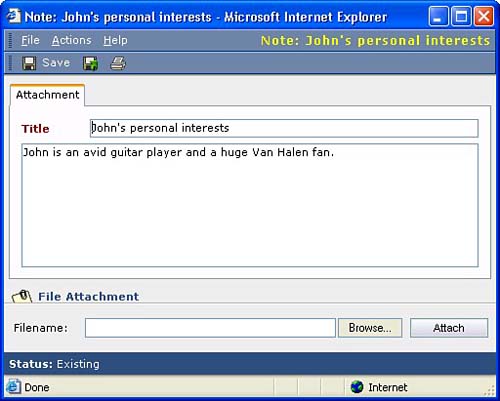
Activities can be assigned to Users and Queues so that, where appropriate, there is a responsibility to take action related to the Activity. Notes cannot be assigned to Users or Queues. They are simply pieces of meaningful data that are attached to a record and require no action. Both Activities and Notes can be attached to nearly every type or record in the system.
When Activities are created they are in “open” status and can be closed and marked as completed or canceled. Chapter 12, “Workflow,” goes into detail on the various record statuses. You can close an Activity by selecting Close Activity from the Actions menu of the Activity screen. After an Activity has been closed, it cannot be modified. Users with appropriate permissions can delete closed Activities. However, it is advisable not to give Activity deletion rights to users. Keeping your Activities intact ensures that you maintain a full history of the interactions with your prospect and customer base.
Unlike Activities, Notes do not have types. Note records consist of a Title, the Note itself, and a document should you choose to attach one. In addition, Notes cannot be closed in the way that Activities can. A closed Activity becomes uneditable whereas Notes are always editable.
Activities are broken into types and house different data depending on the type of Activity you create. There are six different types, as shown in Figure 4.10.
Task
Fax
Phone Call
Email
Letter
Appointment
Figure 4.10. One of six Activities can be selected to create.
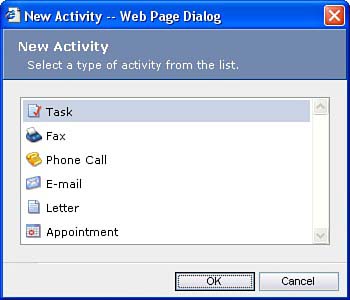
Anywhere you see a grid of Activities in Microsoft CRM you will see two tabs: Activities and History. This is because all Activities are considered open until the user specifically closes them. For example, you might create an Appointment Activity for next week, and then close it, adding your comments, after the appointment has occurred. Email Activities are automatically placed in the closed status and moved to the Activity History tab when they are successfully sent. All Activities have a due date, so you can set goals for their completion.
NOTEMany of the records in Microsoft CRM allow attachment of documents. CRM geeks will undoubtedly want to know how these documents are actually being stored. Attached documents are stored in the Microsoft CRM database in the AnnotationsBase table. The body of the file is stored in the DocumentBody column. Because these files are stored in the database, Microsoft CRM users will be able to access them anywhere they can gain access to the record through Microsoft CRM. However, the files become static when stored in the database. That is to say that a user cannot open an attached file, make a change to it, and then save that change back to the database. To make a change to the file, the user has to open the file, save a copy of it, modify the copy, and then replace the existing attachment with the updated version of the file. All Microsoft CRM file attachments have a five megabyte size limitation. This limitation is enforced server-side, so if you attempt to upload a file that is larger than five megabytes you will receive a message at the point that the server has received enough of the file to realize that it is too big. Figure 4.11 shows the screen the user will see when receiving a file upload error. Figure 4.11. Microsoft CRM file attachments are limited to five megabytes.
|
What's really nice about Activities is that you can track how you are communicating with your prospects and customers. The differentiation between current Activities and History enables you to separate what is pending and what is complete. Perhaps the nicest thing is that when you write an email from Microsoft CRM it is sent to the recipient and added as an Email Activity on the parent record in one action.
Subjects and Products
Products are the things that you sell, no big mystery there. If your Microsoft CRM implementation is integrated to your back-office accounting system the two systems will most likely share a common master list of products. Subjects, however, are an organizational concept that has been introduced in Microsoft CRM. In implementing Microsoft CRM, you create a hierarchy of subjects that will later be related to Products, Service Cases, Sales Literature, and Knowledge Base articles. Think of Subjects as a vehicle for categorization.
Consider the following examples. Your company sells lawn tractors and you want to create a record for a brochure on your signature “Big Cutter” lawn tractor. As far as products go, the Big Cutter could be identified by multiple SKU's (stock keeping units) based on the different models you sell. For example, your Products might include the Big Cutter X1 and Big Cutter X2. However, for the purposes of categorizing the brochure, all you need is a higher level category to represent the Big Cutter product line. That is where subjects come in. In the example of a firm that sells professional services, you might create a Subject for Web Development Projects because you will not have a Product number with which to associate Cases, and so on. Subjects are discussed in more detail in Chapters 5 “Setting up Microsoft CRM,” and 9, “Customer Service.” Figure 4.12 shows an example Microsoft CRM Subject tree.
Figure 4.12. The Microsoft CRM Subject hierarchy.
